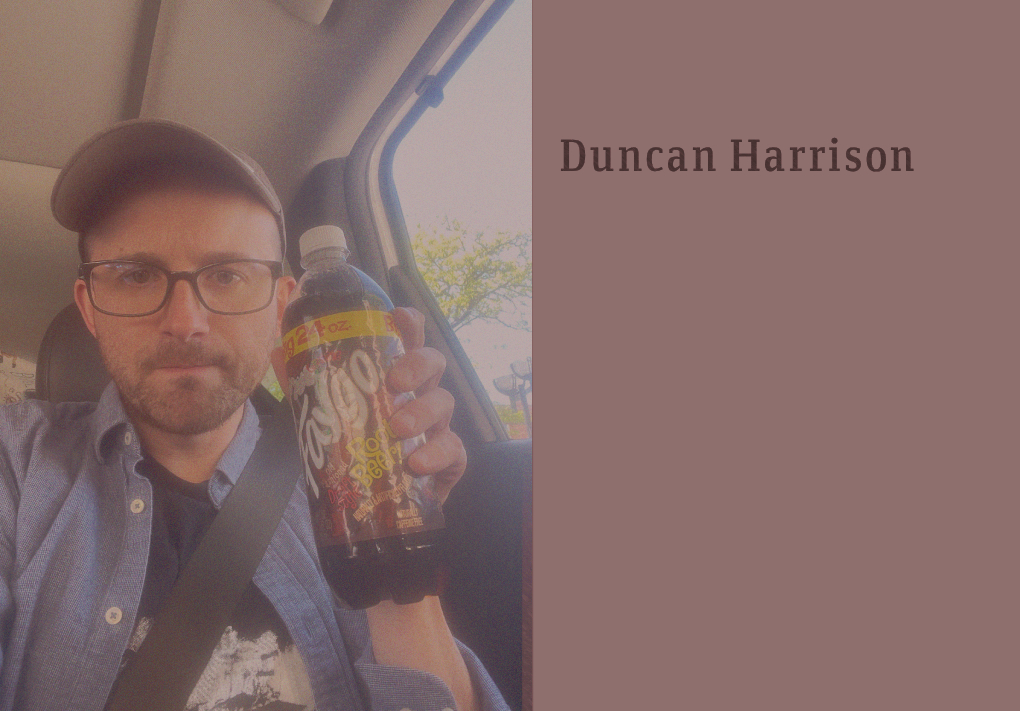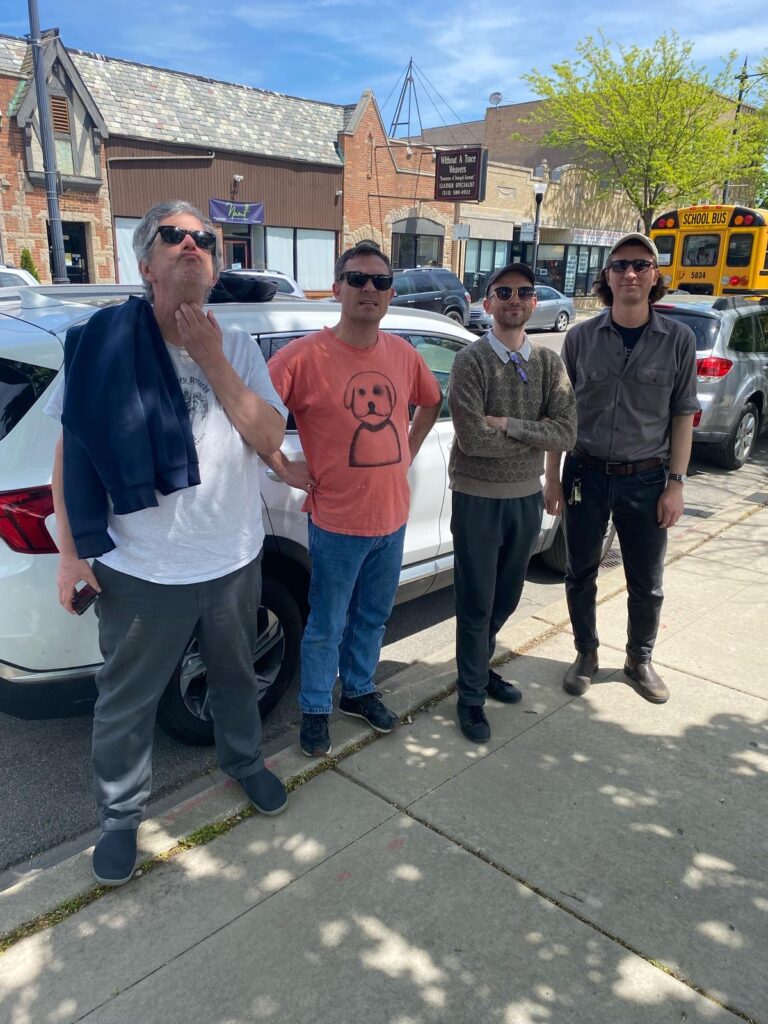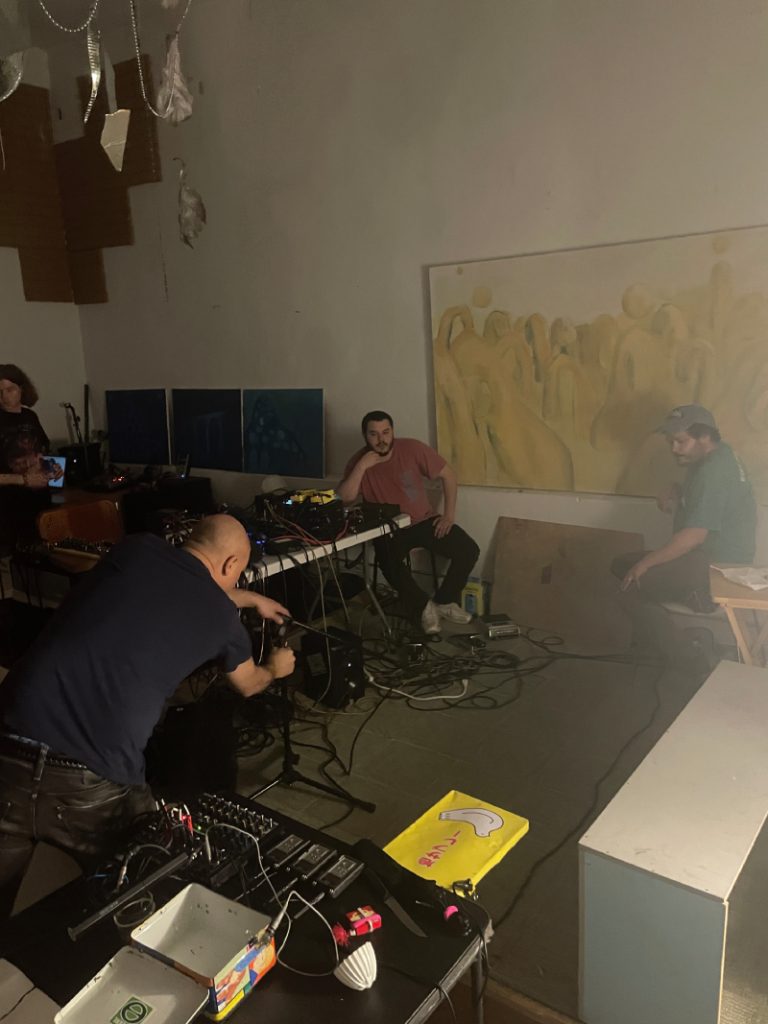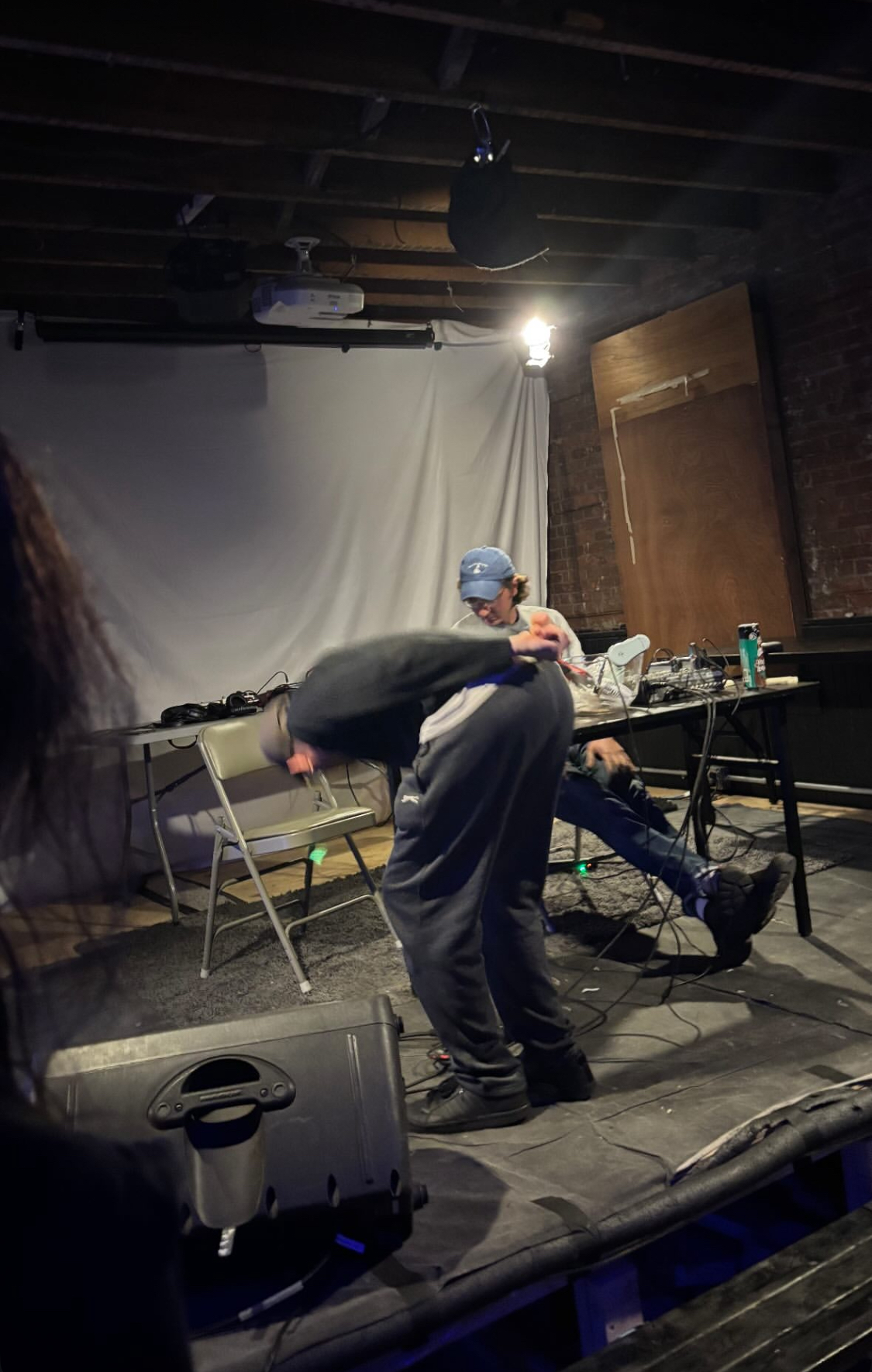
Marios Moras:Duncan, first of all, thank you for sharing some of your time with me. You recently completed a new album under the name “There is No Fire in The Lake” as well as a tour across the United States — so I thought we could focus on those two things throughout this conversation.
This is your first full-length release since 2019 – In your eyes, what’s new or different about this record compared to what you’ve done before?
Duncan Harrison: Hey Marios, nice to talk to you. Yes, I toured the East Coast and a bit of the Midwest of the USA back in May. The album came out alongside 2 other releases on my label adhuman soon after – Ciaran Mackle’s ‘Sitting Still for a Living’ and Kiran Arora’s ‘Virgin Forest’. I’m writing this a few days after getting back from the Netherlands and Belgium doing a couple of gigs with Barn Sour and I think I’m still hungover.
There are probably lots of things that are different about this record from previous work. The most obvious to me is that I was quite strict around how I allowed myself to source and work with all the audio for it. All my releases contain a narrative element of some kind, but I wanted to push that more to the forefront while making this one. I didn’t allow any sounds on this album that didn’t hold a specific relationship to the underlying events or themes that were influencing it. I don’t expect anyone to care about this at all, but it was important to me to create a firm boundary around why and how this album was being made. If I don’t do something like this, I never end up making anything I’m proud of for very long. If I’m trying to tell story of some kind in my music, no matter how abstractly, it helps me feel like I have an easier starting point. The downside is it took way too long to make overall.
MM: In my eyes, listening to your new album, it strikes me as more solid and mature, with a stronger focus on composition. How did you approach putting it together? I’m curious not only about the materials and tools you worked with, but also about the ideas or atmosphere you wanted to convey.
DH: Thank you, I have a heard a few similar comments which are very flattering. I think it’s a slightly more minimal album than others I have made, which comes from trying to allow sounds to breathe a little more and be patient with letting the ideas speak for themselves in each given track. Maybe this is a sign of maturity?! From a personal perspective the album is filled with small comments and reflections about growing, acceptance, getting older and changing your mind about things. I’d guess this fits in with your assessment somewhat too. My life is a lot better now than it was in 2019 when ‘Nothing’s Good’ came out so maybe that has bled into the album. I hope so.
I never like to talk too specifically about tools or technical processes because just I don’t find it all that interesting. I don’t think about equipment much beyond what I need to solve certain problems or produce certain outcomes that I have in mind. It’s all just different combinations of recorded audio being repurposed into building materials for abstract audio works. The technical process of capturing and assembling it is not really important. All my thinking goes into WHY I’m using these sounds in the first place and then a more intuitive process of composing or arranging guided by listening and taste. People are free to engage with it on whatever level they like, of course and if someone wrote to me desperate to know exactly what tape machines, software, plugins and methods I used to make something, I’d obviously tell them.
Your question about the atmospheres intended is a good one. It’s very mixed overall and this might be because the formations of each track were recorded at quite different times and often in very different places. There’s quite an even split between audio gathered whilst away from home and recordings I made in or around the tiny apartment I share with my partner. Very deliberately built from materials gathered at Home vs Away. My friend Tom Betteridge commented on the quality of ‘collaged acoustic spaces’ running throughout the album which I think describes an outcome of this situation. I was thinking a lot about the feelings of comfort and alienation that are to be found in both home life and adventure into the wider word while gathering the sounds, so perhaps some of that has translated into an overall mood to the record.
There are a lot of contributions from other artists on the album too which gave me access to a huge range of unexpected things to work with. A big chunk of material was drawn from a residency I did in Rotterdam during November 2023 with a group of other artists from the UK and Netherlands (check out the album credits for a full list, I’m afraid to miss someone out right now!). I used recorded extracts from large group ensemble jams we did there plus some incidental noises in between. Others were also kind enough to help me with some specific pieces I had intended for the album whilst we were there together. It’s the first time I’ve worked with groups of musicians playing in a room to use for my own music and I’d like to explore this more in the future. My partner features on nearly every track both as a knowing and unwitting recording subject. She particularly helped me a lot with voice recordings and samples of animal sounds which can be heard at different times throughout most of the record. Finally, I asked Jim Strong and Christian Mirande to provide instrumental sections to the penultimate track which is also the most traditionally musical sounding on the record. Their contributions introduced elements to the whole project that blew me away and surprised me whilst still being absolutely in line with what I intended. The introduction of all these other participants was a very new thing that, I hope, massively diversifies the atmospheres and tone of the album.
MM: You recently completed a tour across the United States, which really intrigued me — and to be honest, I imagined this interview as a kind of small road trip through that experience. So, before we dive into all the details, how did the whole idea of setting up a tour in the U.S. come to you? Was it challenging to pull off something like that? Had you done a similar run before, say in Europe?
DH: Yeah, it’s not bad even if I say so myself. I’ll copy and paste the whole route here:
May 1: Philadelphia, PA (Vox Populi Gallery) w/ Melkings May 2: New York City, NY (Kaleidoscope) w/ ShotsMay 3: New Haven, CT (Bradley St Bike Co-Op w/ Cut Nails, Duncan Harrison & Zach Rowden duo) May 4: Providence, RI (Black Lace Gallery) w/ Worth, Robert Fuchs, TDxDH duo, DNZG + RLLNS aka Darksmith & Glass) May 5: Worcester, MA (The Firehouse) w/ Lean feat. Michael Rosenstein May 6: Rochester, NY (Psychic Garden) w/ Cooper Bay, Beastview Maul, TDxDH duo May 7: Pittsburgh, PA (Bantha Teahouse) w/ Slacking May 8 Oberlin, OH (Hanson Records) w/ John Wiese, TDxDH duo May 9 Cleveland, OH (Little Rose Tavern) w/ The DillowaysMay 10 Warren, MI (Tympanum) w/ Creode May 11 Chicago, Il (The Empty Bottle) w/ Guido Gamboa & Stef Patsula duo
Tom DeAngelo came up with the name for the tour. I’ll let him explain: “It’s from “Lost Illusions” by Balzac. I can’t recall which character says it, but it’s meant as a cynical joke about the stereotypical starving artist whose idealistic vision of aesthetic integrity keeps them from bowing to commercial pressures (i.e. this is what your “noble intentions” are really worth in this debased state of affairs”). For obvious reasons I found it fitting to the likes of our lot. If you’ve never read the book I’d highly recommend it. Although Balzac was a true reactionary (monarchist) he had a keen sense of how capitalism devalued art and distorted human interactions in the name of efficiency and instrumentalization. It remains a shockingly accurate account of how the art world, publishing etc. actually function nearly 200 yrs later”.

It was a really pleasant experience to share the trip with all three of those guys. Despite being big fans of them all and sharing a lot in common creatively, I think we each come from quite distinct little areas of weirdo music culture. It was nice to observe the ways our slightly disparate worlds and approaches could mesh together into so many fun events. The most important thing is that we all got on well and shared some good laughs. It’s important to be able to cooperate and be flexible when you’re on tour with other people and I think we did a good job of it.
I have to take some time to give specific respect to each of them as live performers too. S*Glass had a different planned out set for each occasion, often incorporating materials he’d gathered from previously in the day or the night before, whilst Darksmith came with 3 four track tape decks and a big box of cassettes of source material which he would select right before playing. His performances were like seeing a man get into this huge world of sounds ever night. Tom DeAngelo played the same set for each gig besides our duo shows, but it permutated and got more fucked up every time he did it. By the time of his final performance, it had deconstructed into the most amazingly damaged, awkward version of itself. Completely like a different piece somehow, despite being made of all the same components. I’d be honoured to share stages with any of those guys again and hope we will play together more someday.
MM: More broadly, how do you see the American audience for that kind of experimental concert? Did you notice any strong contrasts with the audiences you’re used to in the UK and Europe? And when it came to your own sets, how did they respond? Were there any differences that stood out?
DH: I’m sure there’s something about loving weird, unpopular music that is the same for everyone, everywhere. Many of the audience seemed obsessed over this stuff in the same I am and were asking a lot about music from the UK that I rarely speak to other people about, much less thousands of miles away. Artists at our (low) level so often spend time working in isolation for their own satisfaction and it’s easy to think that hardly anyone is listening. But in the States, I realised there really are people all over the world who follow and understand this music, even only if in small numbers. I do think it’s important for artists to know that somebody likes their work other than themselves and a few of their friends.
People seemed very attentive to my performances, and I hope they enjoyed them. I had some very nice feedback and conversations about it but really, I try not to hold on to that stuff too much. Live performance is such a transient thing I find it easier to just enjoy in the moment then forget about. The performances are only one part of the picture anyway, and just as much of my experience of the audiences were based on socialising with them before and after the music. A lot of the shows ran at a slow, relaxed pace and were clearly social occasions for the local people as well as chances to see touring artists. This is a really similar thing to shows at home in Brighton and part of what I enjoy about them. Perhaps it’s not for everyone and I can acknowledge I’m lucky to feel inclined to socially interact with others at shows, but it gives things a homely, informal feeling which is what I prefer. It’s quite amazing how you can be so far away from where you live to play a gig but feel right at home just because you are around the right kind of people who love the thing you love.
I also think the UK and USA share a lot of the same conditions in so far as how shows are hosted and organised. DIY, not much money, a lot more underground than things might be in Europe, for example. I think only 3 of the shows of the whole tour were in a business venture i.e. bar, venue, cafe. Everything else was held in some under the radar community led space which created a great atmosphere. When I got back from the USA, I felt like I thought this was the best kind of show but having now recently been back to mainland Europe to play I have a renewed appreciation of how they do things there too. Most people I’ve met are all doing it for the same reasons and just have different means of doing so.
MM: Apart from the main line-up, you also shared stages with amazing musicians like Aaron Dilloway, Al Margolis, Shots, Jim Strong, Guido Gamboa, among others. How did it feel to spend time and perform together with them in person?
DH: One correction to make here. The Hudson show got cancelled very short notice because it was due to be outdoors and the rain was really bad, so we had to call it off. This is where Al Margolis would have played so sadly, I didn’t get to meet him in the end. I did still make the utterly irresponsible decision to order a massive load of tapes and CDs from him which he sent to ahead to Chicago for me so at least there was that connection.

Getting to play with all these artists was a dream, really. I couldn’t believe that it was happening at some points, which might seem like a silly thing to say for music that operates on such a small scale but it’s how I felt! Lots of these are people I’ve communicated with for a long time and in some cases met before, so to finally get together on their home turf and watch them play was a total pleasure. It was really cool to see how their local scenes and communities operate given that I’d only seen most of these people due to visiting the UK as touring artists. Every single artist we shared a stage with clearly makes a lot of effort to work for their own unique expression of the music they make, which isn’t always an easy thing to do. Everyone was doing something distinctly based on their own ideas which is hugely encouraging to see anytime. It was a very motivating and unforgettable thing for me to interact with them in person. More than anything I am just a gigantic music obsessive myself and getting to watch amazing bands and artists play for 11 days straight was like paradise.
MM: Could you tell me a bit about the gear you took on this tour? I guess crossing the Atlantic must have made you keep things pretty minimal, right? How did you shape the core structure of your sets with that setup?
DH: My equipment for this tour was an iPad running koala, a small MIDI controller and two tape recorders which I didn’t even use every night. I think there was only one show where I used everything. Sometimes I’d also use a microphone but again it wasn’t every time. This is quite a simple setup but it’s no different from what I would play everywhere, and I have thought quite a lot about how to strip my equipment down to something very minimal and easy to transport over recent years. It was really the same approach I would take with as the iPad allows me to have a massive Bank of loops or longer recordings that I can mix and arrange as I like. Some of these are things I’ve created just for live performances where some of these are samples from my records. The tape recorders are really just there to add a different kind of texture to things if I feel I need it, but then lots of the samples on the iPad come from tape anyway.
Performing in this way gives me lots of different options to improvise while still having a good understanding of what the material is. It allows me to plan as much or as little as I want. There are times when I have completely abandoned the equipment on a whim right as I begin playing, but this didn’t really happen in the states. Like I mentioned before, I’m almost completely uninterested in equipment and only see these things as tools to help me achieve certain objectives, both live and in recorded settings. I’m happy with the idea of my setup staying simple and unchanging until it needs to.
MM: Did you record anything while on tour? I’m wondering if any of those sounds turned into new material, collaborations, or maybe even slipped into the new album itself.
DH: I didn’t make any recordings myself, but other people did at a few shows. I’ve yet to spend any real time listening through them. I’m interested in the recordings of the collaborative sets I did, one with Zach Rowden and three with Tom D’Angelo. Tom and I will be making a record together and I’m sure some of the recordings and ideas from the sets on tour will make their way in. I can definitely see myself working with a lot of people I met on tour as time goes on.

MM: Thanks a lot for your time, Duncan
DH: Thank you! It’s nice to be asked what one thinks about all this stuff from time to time. My only regret is that we could not conduct this interview in person over a few glasses of mythos or alpha. Thanks to anyone who read some/all of this interview.
